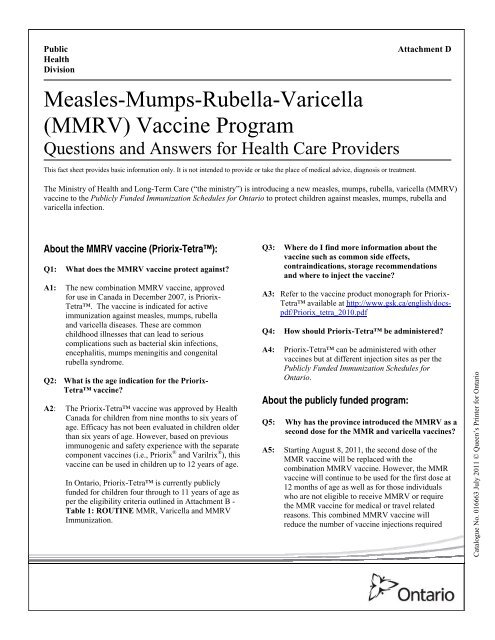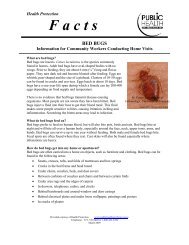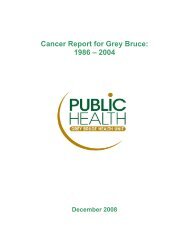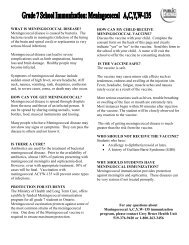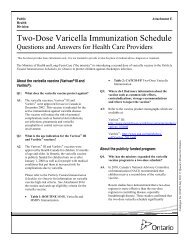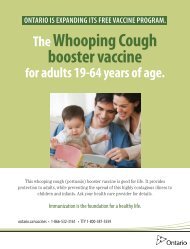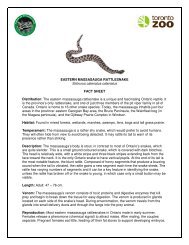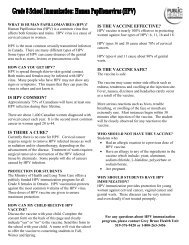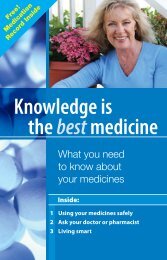Measles-Mumps-Rubella-Varicella (MMRV) Vaccine Program
Measles-Mumps-Rubella-Varicella (MMRV) Vaccine Program
Measles-Mumps-Rubella-Varicella (MMRV) Vaccine Program
Create successful ePaper yourself
Turn your PDF publications into a flip-book with our unique Google optimized e-Paper software.
Public<br />
Health<br />
Division<br />
<strong>Measles</strong>-<strong>Mumps</strong>-<strong>Rubella</strong>-<strong>Varicella</strong><br />
(<strong>MMRV</strong>) <strong>Vaccine</strong> <strong>Program</strong><br />
Questions and Answers for Health Care Providers<br />
This fact sheet provides basic information only. It is not intended to provide or take the place of medical advice, diagnosis or treatment.<br />
Attachment D<br />
The Ministry of Health and Long-Term Care (“the ministry”) is introducing a new measles, mumps, rubella, varicella (<strong>MMRV</strong>)<br />
vaccine to the Publicly Funded Immunization Schedules for Ontario to protect children against measles, mumps, rubella and<br />
varicella infection.<br />
About the <strong>MMRV</strong> vaccine (Priorix-Tetra):<br />
Q1: What does the <strong>MMRV</strong> vaccine protect against?<br />
A1: The new combination <strong>MMRV</strong> vaccine, approved<br />
for use in Canada in December 2007, is Priorix-<br />
Tetra. The vaccine is indicated for active<br />
immunization against measles, mumps, rubella<br />
and varicella diseases. These are common<br />
childhood illnesses that can lead to serious<br />
complications such as bacterial skin infections,<br />
encephalitis, mumps meningitis and congenital<br />
rubella syndrome.<br />
Q2: What is the age indication for the Priorix-<br />
Tetra vaccine?<br />
A2: The Priorix-Tetra vaccine was approved by Health<br />
Canada for children from nine months to six years of<br />
age. Efficacy has not been evaluated in children older<br />
than six years of age. However, based on previous<br />
immunogenic and safety experience with the separate<br />
component vaccines (i.e., Priorix ® and Varilrix ® ), this<br />
vaccine can be used in children up to 12 years of age.<br />
In Ontario, Priorix-Tetra is currently publicly<br />
funded for children four through to 11 years of age as<br />
per the eligibility criteria outlined in Attachment B -<br />
Table 1: ROUTINE MMR, <strong>Varicella</strong> and <strong>MMRV</strong><br />
Immunization.<br />
Q3: Where do I find more information about the<br />
vaccine such as common side effects,<br />
contraindications, storage recommendations<br />
and where to inject the vaccine?<br />
A3: Refer to the vaccine product monograph for Priorix-<br />
Tetra available at http://www.gsk.ca/english/docspdf/Priorix_tetra_2010.pdf<br />
Q4: How should Priorix-Tetra be administered?<br />
A4: Priorix-Tetra can be administered with other<br />
vaccines but at different injection sites as per the<br />
Publicly Funded Immunization Schedules for<br />
Ontario.<br />
About the publicly funded program:<br />
Q5: Why has the province introduced the <strong>MMRV</strong> as a<br />
second dose for the MMR and varicella vaccines?<br />
A5: Starting August 8, 2011, the second dose of the<br />
MMR vaccine will be replaced with the<br />
combination <strong>MMRV</strong> vaccine. However, the MMR<br />
vaccine will continue to be used for the first dose at<br />
12 months of age as well as for those individuals<br />
who are not eligible to receive <strong>MMRV</strong> or require<br />
the MMR vaccine for medical or travel related<br />
reasons. This combined <strong>MMRV</strong> vaccine will<br />
reduce the number of vaccine injections required<br />
Catalogue No. 016663 July 2011 © Queen’s Printer for Ontario
(versus receiving the MMR and varicella vaccines<br />
separately).<br />
There is evidence to suggest that utilizing the<br />
<strong>MMRV</strong> vaccine has the potential to increase the<br />
uptake of the varicella vaccine and, thus, have a<br />
greater impact on controlling varicella disease.<br />
Two doses of the varicella vaccine are now<br />
recommended as part of the routine childhood<br />
schedule. Children will be offered this second dose<br />
of the varicella vaccine in the form of <strong>MMRV</strong><br />
vaccine.<br />
Q6: What is the epidemiology of measles, mumps,<br />
rubella and varicella in Ontario?<br />
A6: Before measles vaccine was used widely, almost<br />
all children got measles. Now, because of the<br />
routine use of vaccine, measles is rare in Canada.<br />
In fact, there were only 81 confirmed cases of<br />
measles reported in Ontario from 2006 to 2010.<br />
These cases were either imported or linked to<br />
imported cases.<br />
During the period 2006-2010, there were three<br />
mumps outbreaks in Ontario, the largest of which<br />
occurred in 2008 and resulted in 324 cases in a<br />
community with low immunization coverage.<br />
During this time there were 564 confirmed cases of<br />
mumps reported in Ontario.<br />
Since 2006, Ontario has reported an average of<br />
three cases (range two to five cases) of rubella per<br />
year with just 14 confirmed cases reported from<br />
2006 through to 2010. These cases were either<br />
imported or linked to imported cases.<br />
<strong>Varicella</strong> is mainly a childhood disease that<br />
develops in 50% of unvaccinated Canadian-born<br />
children before they reach five years of age and in<br />
90% of unvaccinated children before 12 years of<br />
age. Since the introduction of the one-dose<br />
varicella vaccine in 2004, Ontario reported 32,135<br />
cases of chickenpox. Eight hundred and fifty-six of<br />
these cases were severe, resulting in health<br />
complications, hospitalization or death. Since<br />
2008, approximately 7,400 cases of varicella have<br />
been reported annually in Ontario, a 23% reduction<br />
in annual reported cases.<br />
Q8. Why has the ministry moved the second dose of<br />
MMR vaccine from 18 months to the new<br />
<strong>MMRV</strong> vaccine at four to six years of age?<br />
A8. The ministry is continuing to recommend the first<br />
dose of the MMR vaccine at 12 months of age and<br />
the first dose of the varicella vaccine at 15 months<br />
of age as separate injections. For safety reasons,<br />
the ministry is not recommending the <strong>MMRV</strong><br />
vaccine as a first dose nor as a second dose at 18<br />
months of age.<br />
According to post-licensure studies in the United<br />
States on the <strong>MMRV</strong> vaccine, ProQuad , children<br />
who were 12 to 23 months of age were at a greater<br />
risk of febrile seizures when the ProQuad vaccine<br />
was given as the first dose compared with MMR<br />
and varicella vaccines given as a first dose<br />
separately at the same visit 1 .<br />
No data exists regarding the administration of the<br />
first dose of <strong>MMRV</strong> vaccine for children who are<br />
older. However, according to expert opinion, it is<br />
likely that children who are two to under four years<br />
old may experience febrile seizures because that is<br />
the biologic window of vulnerability for febrile<br />
seizures in children.<br />
There have been subsequent studies that compared<br />
the administration of the ProQuad vaccine as a<br />
second dose to children who were four to six years<br />
of age. These studies found that the rate of febrile<br />
seizures in children who received the <strong>MMRV</strong><br />
vaccine, as a second dose between four to six years<br />
of age, was similar to that found in children who<br />
received the second dose of the MMR and varicella<br />
vaccines separately at the same visit.<br />
Based on the available evidence from the<br />
ProQuad studies and in consideration of expert<br />
opinion, the ministry has chosen to offer the<br />
<strong>MMRV</strong> vaccine as a second dose to children who<br />
are at least four to six years of age. Furthermore, it<br />
is anticipated that this change from administration<br />
of the MMR vaccine at 18 months to the new<br />
<strong>MMRV</strong> vaccine at four to six years of age may<br />
help alleviate waning immunity to both mumps and<br />
varicella in later life.<br />
Q7: Who is eligible to receive the publicly funded<br />
<strong>MMRV</strong> vaccine and when should they receive it?<br />
A7: Refer to the eligibility criteria outlined in<br />
Attachment B - Table 1: ROUTINE MMR,<br />
<strong>Varicella</strong> and <strong>MMRV</strong> Immunization.<br />
1 Centers for Disease Control and Prevention. Use of combination<br />
measles, mumps, rubella and varicella vaccine: Recommendations of the<br />
Advisory Committee on Immunization Practices (ACIP). MMRW 2010;<br />
59:1-12.<br />
2
Q9. Are there any risks associated with the second<br />
dose of <strong>MMRV</strong> being given at four to six years<br />
of age rather than at 18 months?<br />
A9. In Ontario, prior to 2005, MMR vaccine was<br />
offered at 12 months and four to six years of age.<br />
In 2005, the immunization schedule for MMR<br />
vaccine was changed to 12 months and 18 months<br />
of age due to a number of factors, mainly to<br />
enhance protection against measles at an earlier<br />
age. Since 2005, Ontario has experienced very few<br />
measles cases. The move to giving the second dose<br />
of MMR vaccine in the form of <strong>MMRV</strong> at four to<br />
six years of age is not expected to increase the risk<br />
of disease. This change to the four to six year old<br />
visit for the second dose as <strong>MMRV</strong> vaccine is<br />
based on consideration of the evidence on the risk<br />
of febrile seizure in children 15 to 23 months of<br />
age as well as waning immunity for mumps (as<br />
evidenced by outbreaks in Ontario) and varicella.<br />
In addition, the <strong>MMRV</strong> vaccine provides<br />
protection against four antigens in a single vaccine,<br />
reducing the number of injections a child receives<br />
and potentially increasing uptake for varicella<br />
immunization. It is highly recommended that<br />
children receive the full immunization series for<br />
measles, mumps, rubella and varicella prior to<br />
school entry.<br />
Q10: What are the detailed schedules for children<br />
who have not completed or have not started<br />
their MMR or varicella vaccine series?<br />
A10: See detailed schedules for MMR, varicella and<br />
<strong>MMRV</strong> immunization series outlined in<br />
Attachment B - Table 3: RECOMMENDED<br />
vaccines and doses required to complete measles,<br />
mumps, rubella and varicella vaccine<br />
immunization series.<br />
Q11: Who should not receive the <strong>MMRV</strong> vaccine?<br />
A11: Children should not receive the vaccine if they<br />
have:<br />
• allergies to the vaccine or any component of<br />
the vaccine;<br />
• known allergies to neomycin; or<br />
• previously experienced an allergic reaction to<br />
any vaccine against measles, mumps, rubella<br />
and/or varicella diseases.<br />
Special considerations are needed for children who<br />
have:<br />
• a weakened immune system or those on<br />
medications that suppress their immune<br />
system;<br />
• a personal or family history of febrile<br />
seizures of any etiology (children should be<br />
vaccinated with the MMR and varicella<br />
vaccines separately);<br />
• previously experienced a severe allergic<br />
reaction to eggs or anything that contained<br />
eggs;<br />
• been given Immune Globulin or blood<br />
products (vaccination should be delayed for<br />
three to 11 months); or<br />
• severe acute febrile illness (administration<br />
of <strong>MMRV</strong> should be postponed; however,<br />
vaccination can occur if the individual has a<br />
minor infection).<br />
Q12: What is the vaccine ordering process?<br />
A12: Order the vaccine through your regular vaccine<br />
supply source (i.e., local public health unit or the<br />
Ontario Government Pharmaceutical and Medical<br />
Supply Service [OGPMSS]).<br />
Q13. How should the <strong>MMRV</strong> vaccine be stored?<br />
A13. In order to ensure that children receive optimal<br />
protection, the <strong>MMRV</strong> vaccine (like other<br />
vaccines) must be maintained at a temperature<br />
between +2°C and +8°C from the time of<br />
manufacture until the vaccine is administered to<br />
individuals. This temperature must be monitored<br />
and maintained at all times.<br />
Q14: What should be done for adverse events<br />
following immunization (AEFIs)?<br />
A14: Under section 38 of the Health Protection and<br />
Promotion Act, R.S.O. 1990, physicians or other<br />
persons authorized to administer an immunizing<br />
agent are required to inform the person who<br />
consents to immunization of the importance of<br />
immediately reporting to a health care provider<br />
any reaction that may be a reportable event.<br />
Local public health units should subsequently be<br />
notified of the adverse event.<br />
The AEFI reporting form can be found on the<br />
Public Health Agency of Canada website along<br />
with a User Guide at: www.phacaspc.gc.ca/im/aefi-form-eng.php.<br />
Send the<br />
completed form to your local public health unit.<br />
A list of health units can be found at:<br />
www.health.gov.on.ca/english/public/contact/phu<br />
/phuloc_mn.html.<br />
3
References:<br />
1. Public Health Agency of Canada. (2006). Canadian<br />
Immunization Guide (7 th ed.).<br />
2. National Advisory Committee on Immunization<br />
(NACI). Statement on measles-mumps-rubellavaricella<br />
vaccine. Canadian Communicable Disease<br />
Report. 2010; 36:1-22. Available from<br />
http://www.phac-aspc.gc.ca/publicat/ccdrrmtc/10vol36/acs-9/index-eng.php.<br />
3. Centers for Disease Control and Prevention. Use of<br />
combination measles, mumps, rubella and varicella<br />
vaccine: Recommendations of the Advisory<br />
Committee on Immunization Practices (ACIP).<br />
MMRW 2010; 59:1-12.<br />
4. <strong>Vaccine</strong> Product Monograph; Priorix-Tetra,<br />
GlaxoSmithKline Inc., May 2010.<br />
http://www.gsk.ca/english/docspdf/Priorix_tetra_2010.pdf<br />
4


